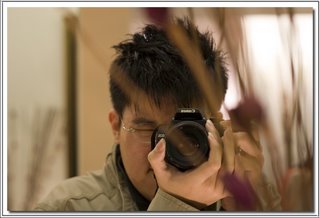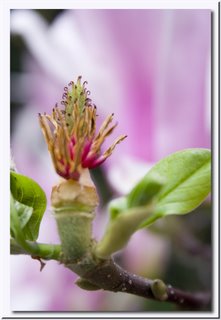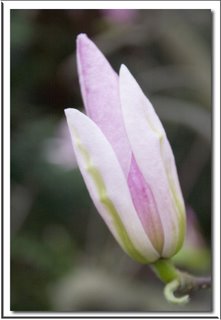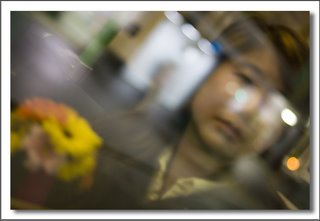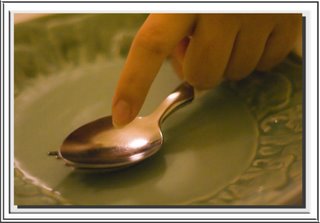
Thursday, 31 August 2006
Alien Hub

Wednesday, 30 August 2006
Curly Catcher
Tuesday, 29 August 2006
Glowing Tips
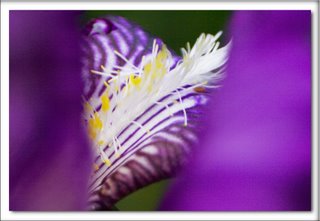
Monday, 28 August 2006
Peace
Sunday, 27 August 2006
Holey Box
Saturday, 26 August 2006
Towering Green
Friday, 25 August 2006
Pixel
A pixel is generally thought of as the smallest complete sample of an image. The definition is highly context sensitive; for example, we can speak of printed pixels in a page, or pixels carried by electronic signals, or represented by digital values, or pixels on a display device, or pixels in a digital camera (photosensor elements). This list is not exhaustive, and depending on context there are several synonyms that are accurate in particular contexts, e.g. pel, sample, byte, bit, dot, spot, etc. We can also speak of pixels in the abstract, or as a unit of measure, in particular when using pixels as a measure of resolution, e.g. 2400 pixels per inch, 640 pixels per line, or spaced 10 pixels apart.
The measures dots per inch (dpi) and pixels per inch (ppi) are sometimes used interchangeably, but have distinct meanings especially in the printer field, where dpi is a measure of the printer's resolution of dot printing (e.g. ink droplet density). For example, a high-quality inkjet image may be printed with 200 ppi on a 720 dpi printer.
The more pixels used to represent an image, the closer the result can resemble the original. The number of pixels in an image is sometimes called the resolution, though resolution has a more specific definition. Pixel counts can be expressed as a single number, as in a "three-megapixel" digital camera, which has a nominal three million pixels, or as a pair of numbers, as in a "640 by 480 display", which has 640 pixels from side to side and 480 from top to bottom (as in a VGA display), and therefore has a total number of 640 × 480 = 307,200 pixels or 0.3 megapixels.
The pixels, or color samples, that form a digitized image (such as a JPEG file used on a web page) may or may not be in one-to-one correspondence with screen pixels, depending on how a computer displays an image.
Many display and image-acquisition systems are, for various reasons, not capable of displaying or sensing the different colour channels at the same site. This approach is generally resolved by using multiple subpixels, each of which handles a single colour channel. For example, LCD displays typically divide each pixel horizontally into three subpixels. Most LED displays divide each pixel into four subpixels; one red, one green, and two blue. Most digital camera sensors also use subpixels, by using coloured filters. (CRT displays also use red-green-blue phosphor dots, but these are not aligned with image pixels, and cannot therefore be said to be subpixels).(courtesy wikipedia.com)
Thursday, 24 August 2006
Wednesday, 23 August 2006
Tuesday, 22 August 2006
Stairway To Heaven
Stairway To Heaven
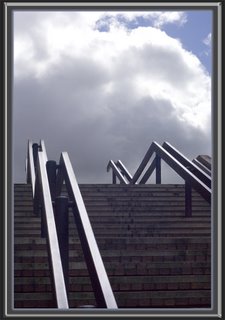
Stairway To Heaven
Zeppelin IV
There's a lady who's sure
All that glitters is gold
And she's buying a stairway to heaven.
When she gets there she knows
If the stores are all closed
With a word she can get what she came for.
Ooh, ooh, and she's buying a stairway to heaven.
There's a sign on the wall
But she wants to be sure
'Cause you know sometimes words have two meanings.
In a tree by the brook
There's a songbird who sings,
Sometimes all of our thoughts are misgiven.
Ooh, it makes me wonder,
Ooh, it makes me wonder.
There's a feeling I get
When I look to the west,
And my spirit is crying for leaving.
In my thoughts I have seen
Rings of smoke through the trees,
And the voices of those who stand looking.
Ooh, it makes me wonder,
Ooh, it really makes me wonder.
And it's whispered that soon
If we all call the tune
Then the piper will lead us to reason.
And a new day will dawn
For those who stand long
And the forests will echo with laughter.
If there's a bustle in your hedgerow
Don't be alarmed now,
It's just a spring clean for the May queen.
Yes, there are two paths you can go by
But in the long run
There's still time to change the road you're on.
And it makes me wonder.
Your head is humming and it won't go
In case you don't know,
The piper's calling you to join him,
Dear lady, can you hear the wind blow,
And did you know
Your stairway lies on the whispering wind.
And as we wind on down the road
Our shadows taller than our soul.
There walks a lady we all know
Who shines white light and wants to show
How ev'rything still turns to gold.
And if you listen very hard
The tune will come to you at last.
When all are one and one is all
To be a rock and not to roll.
And she's buying a stairway to heaven.
(courtesy diamond-back.com)
Monday, 21 August 2006
Boring Tram
Sunday, 20 August 2006
Japanese Tea

The Kinds of Japanese Teas
Green Teas which are stoped fermentation by steaming.
SENCHA
The most popular type of Green Teas. About 85% of Japanese teas are SENCHA. In both quality and price SENCHA has a wide variety.
High quality one is served only on special occasions.But average qualities are for everyday use.
GYOKURO
This is the vest Japanese Tea. It is a precious tea and it si served as a treat to visitores. GYOKURO means "the dew of jewels".
GYOKURO has a stronger flavor and aroma with less bitterness tha SENCHA. This is because when the buds are about to come out, the teas bushes are shaded.
MACCHA
This is known as using TEA CEREMONY.
This is a type of tea ground to a fine powder. To make MACCHA tea is mixed in hot water with banboo whisk.
This is understood as a lowest grade of TEA.
But some BANCHA is very nice as a different meaning.
It has a very simple taste, so it is pleased to drink after meals or to drink when thirsty.
HOUJICHA
This is a roasted BANCHA.
It has a brown color and unique tosted flavor, and light golden beer color when steeped.
It is also pleased to drink after meals or when thirsty.
The way to serve HOUJICHA is same as BANCHA.
MECHA
It is tea buds selected while refining SENCHA or GYOKURO.
It has strong flavor and taste. It is better than caffee when standing sleeepy.
KUKICHA
It is tea stems also selected while refining.
It taste light and has fresh flavor. It is also everyday use.
GENMAICHA
It is a mixture of BANCHA and popped GENMAI (hulled rice kernels). It makes a light brown tea with a savory flavor. It is also everyday use.
- The way to serve GENMAICHA is same as KUKICHA.
- (courtesy iris.or.jp)
-
Saturday, 19 August 2006
Frenzied

Friday, 18 August 2006
Thanks
Thursday, 17 August 2006
Groceries

Wednesday, 16 August 2006
Other Bumble Bee
Tuesday, 15 August 2006
San San

Monday, 14 August 2006
Smoothie Reflection
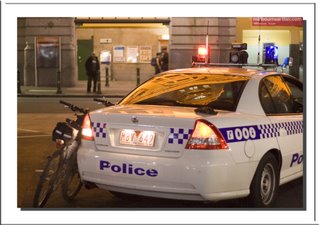
Sunday, 13 August 2006
Hose

A firehose is a thick, high-pressure hose used to carry water or other fire retardant (such as foam) to a fire to extinguish it. Outdoors, it is attached either to a fire engine or a fire hydrant. Indoors, it can be permanently attached to a building's standpipe or plumbing system.
The usual working pressure of a firehose can vary between 8 Bar (0.8 MPa) - 20 bar (2.0 MPa), while its bursting pressure can be up to 63 bar (6.3Mpa). (This level of pressure emitted by the hose can actually break in a weaker brick wall.)
This high pressure also allows the fire hose to serve as an effective form of crowd control, including most notably by Bull Connor in the Deep South against civil rights protestors.
(courtesy wikipedia.com)
Saturday, 12 August 2006
Ellipse

Taken in Melbourne University Baillieu. This was the stairs which I decided to shoot when we were having break.
In mathematics, an ellipse (from the Greek for absence) is the locus of points on a plane where the sum of the distances from any point on the curve to two fixed points is constant. The two fixed points are called foci (plural of focus).
(courtesy wikipedia.com)
An ellipse is a type of conic section: if a conical surface is cut with a plane which does not intersect the cone's base, the intersection of the cone and plane is an ellipse. For a short elementary proof of this, see Dandelin spheres.
Algebraically, an ellipse is a curve in the Cartesian plane defined by an equation of the form
- Ax2 + Bxy + Cy2 + Dx + Ey + F = 0
such that B2 <>, where all of the coefficients are real, and where more than one solution, defining a pair of points (x, y) on the ellipse, exists.
An ellipse can be drawn with two pins, a loop of string, and a pencil. The pins are placed at the foci and the pins and pencil are enclosed inside the string. The pencil is placed on the paper inside the string, so the string is taut. The string will form a triangle. If the pencil is moved around so that the string stays taut, the sum of the distances from the pencil to the pins will remain constant, satisfying the definition of an ellipse.
Friday, 11 August 2006
Where's My Food
Thursday, 10 August 2006
Way To City
Wednesday, 9 August 2006
Orchid
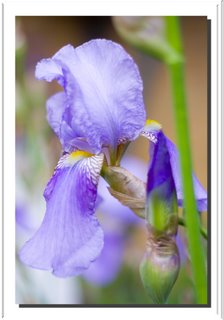
Orchids (Orchidaceae family) are the largest and most diverse of the flowering plant (Angiospermae) families, with over 800 described genera and 25,000 species. Some sources give 30,000 species, but the exact number is unknown since classification differs greatly in the academic worldAbout 800 new species are added each year. Orchids, through their interactions with pollinators and their symbiosis with mycorrhizae fungi, are considered by some, along with the grasses, to be examples of the most advanced (derived) floral evolution known.
One orchid genus, Vanilla, is commercially important, used as a foodstuff flavoring, the source of vanilla. The underground tubers of terrestrial orchids are ground to a powder and used for cooking, such as in the hot beverage salep or the so-called "fox-testicle ice cream" salepi dondurma. The scent of orchids is frequently used by perfumists (using Gas-liquid chromatography) to identify potential fragrance chemicals. With these exceptions, orchids have virtually no commercial value other than for the enjoyment of the flowers (see also Botanical orchids).
Orchids get their name from the Greek orchis, meaning "testicle", from the appearance of subterranean tuberoids of the genus Orchis. The word "orchis" was first used by Theophrastos (372/371 – 287/286 BC), in his book "De historia plantarum" (The natural history of plants). He was a student of Aristotle and is considered the father of botany and ecology.
(courtesy wikipedia.com)
This is an Iris, not an orchid. The flag Iris is the national flower
of France, & is the origin of the fleur de lis symbol, which incidentally is part
of the [Trinity] College emblem!
(courtesy of Tamar Lewit)
Lecturer in Charge, History of Ideas in Trinity College
Tuesday, 8 August 2006
Fire

Fire is a phenomenon of combustion manifested in intense heat and light in the form of a glow or flames. The word fire when used with an indefinite article is commonly used to describe either a fuel in a state of combustion (such as a campfire or a fire in a fireplace or kitchen stove) or an instance of violent, destructive and uncontrolled burning (such as a wildfire and fires in buildings and vehicles).
Fire is not a state of matter: rather, it is an exothermic chemical reaction accompanied by intense heat released during a rapid oxidation of combustible material. Fire may be visible as the brilliant glow and flames and may produce smoke.
Fires start when a flammable or combustible material with adequate supply of oxygen or other oxidizer is subjected to enough heat. The common fire-causing sources of heat include a spark, another fire (such as an explosion, a fire in the oven or fireplace, or a lit match, lighter or cigarette) and sources of intense thermal radiation (such as sunlight, a flue, an incandescent light bulb or a radiant heater). Mechanical and electrical machinery may cause fire when combustible materials used on or located near the equipment are exposed to intense heat from Joule heating, friction or exhaust gas. Fires can sustain themselves by the further release of heat energy in the process of combustion and may propagate, provided there is continuous supply of oxygen and fuel. Fires may become uncontrolled and cause great damage to and destruction of human life, animals, plants and property.
Fire is extinguished when any of the elements of so-called fire triangle—heat, oxygen or fuel—is removed. The unburnable solid remains of fire are called ash.
- Oxyacetylene Flame (3000 C or above)(5432 F)
- Oxyhydrogen Flame (2000 C or above)(3632 F)
- Bunsen Burner Flame (Max. Setting) (1300 - 1600 C)(2372 - 2912 F)
- Candle Flame (1400 C)(2552 F)
- Blowtorch (1300 C)(2372 F)
- Log fire (1000 C ~)(1832 F)
- Heather Fire (500 1000 C~)(932 1832 F)
- Paper — (approximately 235 C)(455 F)
- Class A: Fires that involve flammable solids such as wood, cloth, rubber, paper, and some types of plastics.
- Class B: Fires that involve flammable liquids or liquifiable solids such as petrol/gasoline, oil, paint, some waxes & plastics, but not cooking fats or oils.
- Class C: Fires that involve flammable gases, such as natural gas, hydrogen, propane, butane.
- Class D: Fires that involve combustible metals, such as sodium, magnesium, and potassium.
- Shock Risk (formerly known as Class E): Fires that involve any of the materials found in Class A and B fires, but with the introduction of an electrical appliances, wiring, or other electrically energized objects in the vicinity of the fire, with a resultant electrical shock risk if a conductive agent is used to control the fire.
- Class F: Fires involving cooking fats and oils. The high temperature of the oils when on fire far exceeds that of other flammable liquids making normal extinguishing agents ineffective.
Monday, 7 August 2006
Sunday, 6 August 2006
Pointy
Saturday, 5 August 2006
Kaspar

Name: Kaspar
Gender: Male
Origin of name: Persian
Meaning: A treasured secret
(courtesy parenthood.com)
Friday, 4 August 2006
Chandra
Thursday, 3 August 2006
Sakura

Do not ask me why Sakura. It's nothing weird with the name, just weird with the timing. It's winter here in Melbourne and my school somehow has sakura flower blooming. nice tree anyway. all the rises had died and cut and there is this new pink tree by the corner. Click to see a larger photo which had some water droplets on it.
Sakura (Japanese kanji: 桜 or 櫻; hiragana: さくら; katakana: サクラ) is the Japanese name for ornamental cherry trees, Prunus serrulata, and their blossoms. Cherry fruit (known as sakuranbo) come from a different species of tree.
Sakura, a well-known and ubiquitous symbol of Japan, are represented on all manner of consumer goods, including kimono, stationery, and dishware. Cherry blossoms are an enduring metaphor for the ephemeral nature of life, and as such are frequently depicted in art, and are associated with both samurai and kamikaze. There is at least one popular folk song, originally meant for the shakuhachi (bamboo flute), titled "Sakura", as well as a number of pop songs. "Sakura" is also a common Japanese female name.
Annually, the Japanese track the sakura zensen, or Cherry-Blossom Front. Nightly forecasts follow the weather segment of news programs. The blossoming begins in Okinawa in February, and typically reaches Kyoto and Tokyo at the end of March or the beginning of April. Then it proceeds north, arriving in Hokkaido a few weeks later. Japanese pay close attention to these forecasts. They will go to parks, shrines and temples with family and friends and hold a "flower viewing party" known as hanami (花見). Hanami festivals celebrate the beauty of sakura, and for many, it is a chance to relax and enjoy the beautiful view.
During World War II, the sakura served as a motivating symbol for the Japanese people. Japanese pilots would paint them on the sides of their planes before embarking on a suicide mission. A cherry blossom painted on the sides of the bomber symbolized the beauty and ephemerality of nature [1]. The government encouraged the people to believe that the souls of downed warriors were reincarnated in the blossoms.
(courtesy wikipedia.com)
Note: Sold with 6 other pictures for a total of A$50
Wednesday, 2 August 2006
Traffic Lights
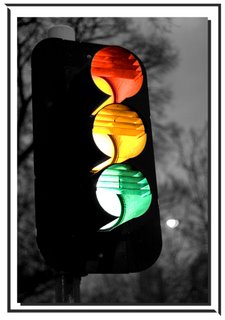
Taken near my house toad junction. This photo consist of three shots showing three diferrent state of the traffic light and combined by photoshop. The rest of the picture is made into black and white.
In most countries, the sequence is red (stop), green (go), amber (prepare to stop). In the UK and Canada, amber officially means 'stop' but in practice, is treated as 'prepare to stop'. In the UK, Hong Kong, mainland China, Germany, Poland, and Iceland, among others, the sequence includes red + amber together before green, which helps draw attention to the impending change to green, to allow drivers to prepare to move off. (In many of these jurisdictions, such as the UK, it is customary for drivers to shift into neutral and/or set the parking brake at red lights; the additional phase gives the driver time to shift into gear/release the brake before the light turns green). The single flashing amber signal is used in the UK and Australia at Pelican crossings. Some older signals in New England, mainly near Boston, use the red + amber phase to signify an all-pedestrian phase ("Barnes dance"), as they were installed before pedestrian signals came to the area, and before the national standard prohibited them. See "Pedestrian scrambles" below, or the main article.
In the mid 1990s, cost-effective traffic light lamps using light-emitting diodes (LEDs) were developed; prior to this date traffic lights were designed using incandescent or halogen light bulbs. Unlike the incandescent-based lamps, which use a single large bulb, the LED-based lamps consist of an array of LED elements, arranged in various patterns. When viewed from a distance, the array appears as a continuous light source (unless closely examined).
LED-based lamps have numerous advantages over incandescent lamps; among them are:
- Much greater energy efficiency
- Much longer lifetime between replacement, measured in years rather than months. Some of the longer lifetime is due to the fact that the light is an array which allows the light to be used even if some of the LEDs in the array are dead.
- Brighter illumination with better contrast even in direct sunlight.
- The ability to display multiple colors and patterns from the same lamp. Individual LED elements can be enabled or disabled, and different color LEDs can be mixed in the same lamp.
- Much faster switching.
The operational expenses of LED-based signals are far lower than equivalent incandescent-based lights. As a result, most new traffic light deployments in the United States, Canada and elsewhere have been implemented using LED-based lamps; in addition many existing deployments of incandescent traffic lights are being replaced. Many of the more exotic traffic signals discussed on this page would not be possible to construct without using LED technology.
In some areas, LED-based signals have been fitted (or retrofitted) with special Fresnel lenses and/or diffusers to limit the line of sight to a single lane. These signals typically have a "projector"-like visibility; and maintain an intentionally limited range of view.
In the late 1990s, a national standardization effort known as the Advanced transportation controller (ATC) was undertaken by the Institute of Transportation Engineers. They are attempting to create a single national standard for traffic light controllers. The standardization effort is part of the National Intelligent transportation system program funded by various highway bills, starting with ISTEA in 1991, followed by TEA-21, and subsequent bills.
(courtesy wikipedia.com)
